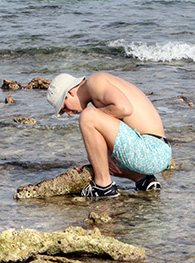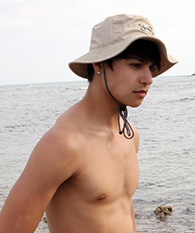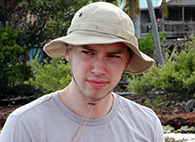Tuesday was a day of contrast along South Water Caye in Belize. Those contrasts provided quite an immersive laboratory for the BIO 322 students.
The morning session featured snorkeling along the fore reef not far from the IZE Belize research facility where the group is based. The students submerged themselves along the outside of the reef – the world’s second-longest coral reef in in open water between 40-60 feet deep.
 It was everything one could imagine. Corals, comb jellies, anemones, reef fish, even a resting Nurse Shark, as far as your goggles and fins could take you on a scale “way more massive than anything we’ve seen before,” said Ben Jansen ’24.
It was everything one could imagine. Corals, comb jellies, anemones, reef fish, even a resting Nurse Shark, as far as your goggles and fins could take you on a scale “way more massive than anything we’ve seen before,” said Ben Jansen ’24.
The afternoon was highlighted by an excursion to tidal pools on the north end of the island. During low tide a plethora of brittle stars, sea urchins, crabs, worms, and more can be found simply by touch. Turn over a rock and see what’s there. It’s normal to discover multiple species inhabiting the same rock.
It was macro vs. micro. Big picture vs. hands-on learning. So which environment did the students prefer?
“It’s difficult to choose which one I prefer because they both offer different aspects of invertebrates, but I would go with the snorkeling because you really got to see these different invertebrates in their natural environments under water,” said Mitchell Keeling ’23. “Under water is a different element, obviously, and that’s something I haven’t experienced before.”
Jansen linked his decision to knowledge gained in class, saying, “Snorkeling was really powerful, but in terms of applying things we’ve learned from class, definitely the tidal pools were really cool because every rock you flip over there were so many applications you could have.”
 One interesting aspect of immersion trips is the explosion of experience when the guys get on site. Takeshi Greiner ’24 used a bit of advice from biology professor Dr. Eric Wetzel to make the sensory inputs manageable.
One interesting aspect of immersion trips is the explosion of experience when the guys get on site. Takeshi Greiner ’24 used a bit of advice from biology professor Dr. Eric Wetzel to make the sensory inputs manageable.
“The common theme Dr. Wetzel has been saying over and over is to take it slow,” he said, “to really look closely at things and don’t go too fast. Applying that to the snorkeling is pretty helpful in making sure you can see all you want to see.”
The students bring six weeks of classroom and lab experience with them, and the rewards of overturning a rock in the tidal pool and being able to identify it and its unique characteristics is instantly rewarding. There is also the revelation that there is much more to learn, especially in an environment found in Belize.
“We’ve not taken the steps to break it down like we have on this trip and see how this whole ecosystem works,” explained Keeling. “It’s given me a greater understanding of marine ecology and the organisms that contribute to it.”
Jansen was more succinct. “To put all the pieces together – this is life after all – is pretty cool.”
One quip the students have heard from Dr. Wetzel more than once this week is that little things run the world. While those words were meant to focus attentions on the bottom of the ecological pyramid, there are other lessons, too.
“This trip has really strengthened the bond with my Wabash brothers here,” said Greiner. “I’ve grown close with the other guys here.”
Jansen agreed.
“No words can describe this place and how thankful I am for Wabash and the alumni who set up the endowments for us to be here,” he said “It’s an incredible experience. Not only the views and the place where we’re staying, but with the relationships we’re building, and the active, hands-on learning we’re doing. That is invaluable. It exponentially increases how much we are taking in.”